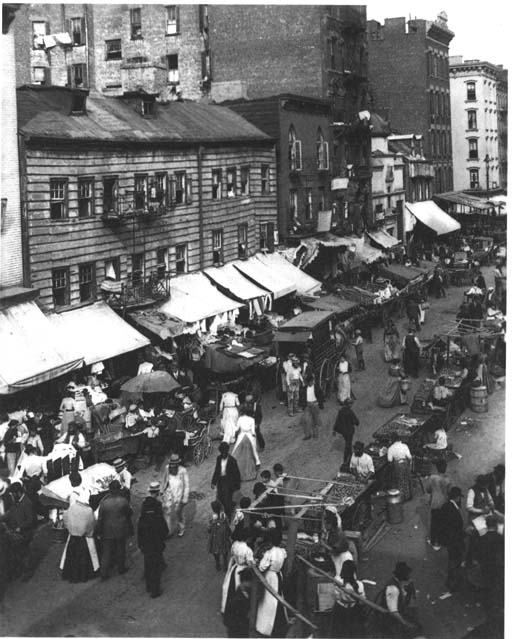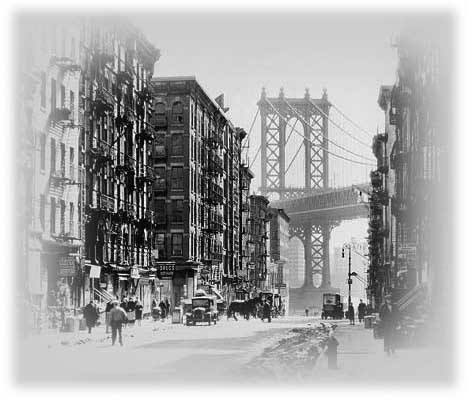

Unfortunately, Synagogue Space as an arts organization ceased to exist shortly after the showing of the One World Postal Art Show. Until that time, Synagogue Space was a place to show artwork and projects affiliated with the Danspace Workshop. It was housed in a tiny synagogue on East First Street near Avenue A across from Katz's Deli on Houston on the Lower East Side of New York.
Part of the mission chosen by the directors of The Synagogue Space was to preserve the aesthetic integrity of the synagogue building, and to foster an appreciation of its history. That is what this web page is about.
The building, located at 108 East First Street was built
in 1926 as a synagogue for Congregation Masas Benjamin,
made up of immigrants from the Galician village of Podhajce
(pronounced pod-IYET-sah). This village was home to a Jewish community of almost
3,000 persons. In Autumn 1942 the Nazis removed the inhabitants to the camp
at Belzec for extermination. The Jewish community in Podhajce no longer exists.
The Congregation of the People of Podhajce no longer
exists, either. The once-thriving Jewish community of the Lower
East Side has shrunk significantly, due to the far more benign forces of
demographic shift and economic mobility. Left in the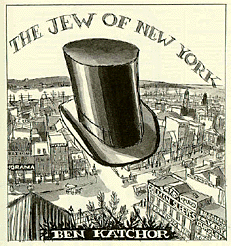 wake are dozens of small synagogues, many of which have been demolished or converted
into apartment buildings. While it is not violent pogroms which have driven
the former congregants from the neighborhood, but rather economic success, the
sight of a formerly vibrant synagogue left to crumble into disrepair is no less
lamentable.
wake are dozens of small synagogues, many of which have been demolished or converted
into apartment buildings. While it is not violent pogroms which have driven
the former congregants from the neighborhood, but rather economic success, the
sight of a formerly vibrant synagogue left to crumble into disrepair is no less
lamentable.
Preserving the aesthetic integrity of this particular synagogue building, and the rich history of this neighborhood remains as important to the creator of the One World Postal Art Show as it was to the hosts.
Congregation Masas Benjamin Anshe Podhajce was organized in 1895
by immigrants from the village of Podhajce (pronounced
pod-IYET-sah) in Galicia (southeastern Poland). In 1926 the congregation bought
a three-story building at 108 East First Street which they extended and restructured
to be a synagogue. Today, the building includes a two-story high sanctuary
with stained glass windows and skylight.
The building, modified as a synagogue, consisted of a first floor study, a second floor sanctuary, and a third floor women's section. The sanctuary is decorated with the images of the twelve Zodiac signs and the associated months of the Jewish calendar. A tall marble tablet on the sanctuary wall lists in Hebrew the names of deceased members of the congregation. Marble inscriptions outside the sanctuary list the congregations officers and contributors to the synagogue. The front gate reads, in Yiddish, "Contributed by the Podhajce Ladies Auxiliary."
As early as the 1920s, the building was being shared
with another congregation calling itself Congregation Rodeph Shalom Independent
Podhajce. By the early 1980s the building was being used by Congregation Kochob
Jacob Anshe Kamenitz-Lit (of Kamenitz, Lithuania). The building lay idle from
about 1985 until 1990, when it became home to Congregation Beth Yitzchok. The
Synagogue Space was founded in 1995. The beautiful building where Synagogue
Space was once located is now a private residence and has undergone extensive
rennovations.
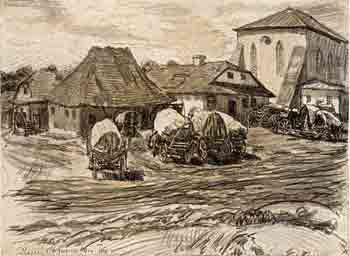 Located in Eastern Galicia, Podhajce was the property of a variety
of states. Prior to the First World War, Podhajce was part of the Austro-Hungarian
Empire; between the wars it was Polish territory; today it is the Ukranian town
of Podgaitsy.
Located in Eastern Galicia, Podhajce was the property of a variety
of states. Prior to the First World War, Podhajce was part of the Austro-Hungarian
Empire; between the wars it was Polish territory; today it is the Ukranian town
of Podgaitsy.
The 1970 Encyclopedia Judaica contains the following
entry:
Podgaitsy (Pol. Podhajce), city, W.
Tarnopol Oblast, Ukranian S.S.R. A Jewish community existed in Podgaitsy during
the 16th century. At the beginning of the 17th century the rabbinical seat was
held by Benjamin Aaron b. Abraham Solnik, who died in 1610. He published a collection
of 112 responsa and legal novellae in his work Masat Benjamin. After the invasion
of the town by the Tatars in 1667 and the massacre which they perpetrated among
the Jews, R. Ze'ev b. Judah Leib wrote an elegy in memory of the victims. According
to the census of 1764 th ere were 1,079 Jews. During the 19th century, under
Austrian rule, the Jewish population increased, and by 1910 numbered about 6,000.
However, Podgaitsy's importance subsequently declined and according to the census
of 1931 only 2,872 Jews were left.
Holocaust Period When the war broke out between Germany and the U.S.S.R. (June 22, 1941), Podgaitsy was occupied by the Germans, and the Jews immediately became victims of attacks by the Ukranian population. They were forced to pay fines, the ir movement was restricted outside the city, and they were subject to forced labor. L. Lilenfeld headed the Judenrat. In the winter of 1941/42 many died from hunger and disease. On Sept. 21, 1942, over 1,000 Jews were sent to the Belzec death camp, and on October 30, 1,500 people were sent there. Survivors of the community tried to find shelter in neighboring forests; due to informers, however, many fell into German hands and were executed. On June 6, 1943, the community was completely liquidated and the ghetto and the city were declared judenrein. After the war the community was not reconstituted.
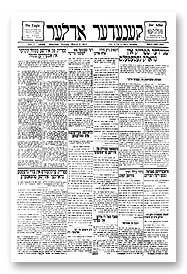 The year 1880 is regarded as the beginning of the massive immigration
which brought over two million Jews to America. As the Yiddish-speaking Jews
arrived on the Lower East Side in large numbers, the German-speaking Jews moved
out of the neighborhood to the more affluent neighborhoods of upper Manhattan.
By 1905, the high-point of immigration, the neighborhood was home to 350 active
congregations, most of which operated out of storefront shuls. There were a
full 60 synagogue buildings in the neighborhood. (Reference:
The Synagogues of the Lower East Side by Jo Renee Fine and Gerard R.
Wolfe)
The year 1880 is regarded as the beginning of the massive immigration
which brought over two million Jews to America. As the Yiddish-speaking Jews
arrived on the Lower East Side in large numbers, the German-speaking Jews moved
out of the neighborhood to the more affluent neighborhoods of upper Manhattan.
By 1905, the high-point of immigration, the neighborhood was home to 350 active
congregations, most of which operated out of storefront shuls. There were a
full 60 synagogue buildings in the neighborhood. (Reference:
The Synagogues of the Lower East Side by Jo Renee Fine and Gerard R.
Wolfe)
By the 1900s, many families were moving over the bridge
to Brooklyn or up to The Bronx, however they continued to be replaced by a flow
of new immigrants. When Congress restricted immigration in 1924, those leaving
the neighborhood were no longer being replaced by fellow Eastern-European Jews.
The population dwindled, and in the 1950s began to be replaced by immigrants
from Puerto Rico. The neighborhood also saw the development of a noteable Polish
and Ukranian community, which continues to the present. In the 1960s, artists
who could no longer afford the rising rents of Greenwich Village began moving
here, giving rise to the East Village in the area north of Houston Street. In
the last twenty years, Chinatown has expanded into much of the southern part
of the neighborhood, and there is a continuing influx of immigrants from the
Dominican Republic.
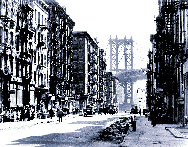 As a result, the Lower East Side today is an ethnic mix, with world-famous kosher
pickles being sold down the block from the finest Chinese pork buns and heaping
plates of arroz con habichuelas, not far from purveyors of homemade
kielbasa and the social scene of hip coffee houses. Small off-off Broadway theaters
and underground art galleries compete for attention with shops selling bar mitzvah
sets and others offering good-luck candles decorated with Carribbean religious
motifs. There is no doubt that the Lower East Side remains one of New York City's
most vibrant and fascinating neighborhoods.
As a result, the Lower East Side today is an ethnic mix, with world-famous kosher
pickles being sold down the block from the finest Chinese pork buns and heaping
plates of arroz con habichuelas, not far from purveyors of homemade
kielbasa and the social scene of hip coffee houses. Small off-off Broadway theaters
and underground art galleries compete for attention with shops selling bar mitzvah
sets and others offering good-luck candles decorated with Carribbean religious
motifs. There is no doubt that the Lower East Side remains one of New York City's
most vibrant and fascinating neighborhoods.
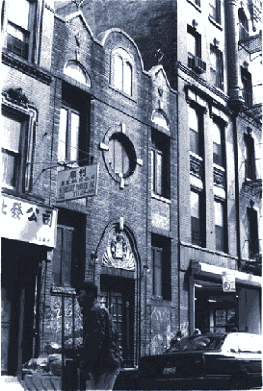 Eldridge
Street Synagogue, 14 Eldridge Street, 212-619-0888
Eldridge
Street Synagogue, 14 Eldridge Street, 212-619-0888
The First Roumanian-American
Synagogue on Rivington Street has stood for generations as a landmark
of the Lower East Side. The building at 89 Rivington Street was originally
built between around 1857 as the German Evangelical Church. Designed to
convert Jews, it was bought in 1864 by Shaaray Hashomayim, (Gates of Heaven),
New Yorkıs oldest Orthodox German-Jewish congregation. It reverted to a
church in 1890, when a Methodist mission society moved the Allen Street
Memorial Church here. Finally the current congregation bought it in 1902
and quickly became one of the most celebrated synagogues in the thriving
Jewish neighborhood that was the Lower East Side.
One of the oldest synagogues in the city, it has a past as rich
as the neighborhood itself. The voices of such great cantors as Moishe Oysher,
Yossele Rosenblatt, Moishe Koussevitsky, Jan Peerce and Richard Tucker have
all resounded through the wonderful acoustics of the Roumanishe Shul.
It earned the nickname "The Cantor's Carnegie Hall" because of its many
famous congregants, mostly in music, but it also included as a congregant
the comedian George Burns, and his compadres Red Buttons and Eddie Cantor,
who also sang in the choir.
The Romanesque-style building got a well-deserved facelift in
the 1990s. The congregation had been dwindling for many years. Graffiti
and peeling paint were removed from the facade, making the synagogue as
handsome as it looked in decades. On Shabbos and holidays, the shul served
residents of the local Jewish community. The shul continued to offer daily
services at 8 am and 5 pm, primarily attended by the shopkeepers from adjacent Orchard Street. Then in January 2006, its roof
collapsed into its famous sanctuary and remained off limits even to congregants
as city inspectors warned of instability in one of its walls. Nine residents
of an adjacent apartment building at 87 Rivington Street, including two
children, were being temporarily housed in hotels because of the threat
of further deterioration. Congregants have pledged to repair their badly
damaged, 150-year-old building, or else build anew in the same spot.
shopkeepers from adjacent Orchard Street. Then in January 2006, its roof
collapsed into its famous sanctuary and remained off limits even to congregants
as city inspectors warned of instability in one of its walls. Nine residents
of an adjacent apartment building at 87 Rivington Street, including two
children, were being temporarily housed in hotels because of the threat
of further deterioration. Congregants have pledged to repair their badly
damaged, 150-year-old building, or else build anew in the same spot.
The person who made the web pages- now defunct and gone-
that this HTML page is based on was:
I was able to re-create some of the content, combine everything he did onto this one page and add new pictures and updated links. I am glad Jeff originally made the pages and wrote the copy. I am also grateful that the directors of the space saw the One World Postal Art Show as something that fit into what they were trying to do with their organziation.
-Mark Bloch 2006
http://www.thelowereastside.org/Book.html
http://www.pupress.princeton.edu/chapters/s6919.html
http://www.agiftforlaughter.com/description.htm
http://www.schapiro-wine.com/yiddish.html
http://www.schapiro-wine.com/eastside.html
http://www.jewishvirtuallibrary.org/jsource/Judaism/synukraine.html
